|
|
|
Sort Order |
|
|
|
Items / Page
|
|
|
|
|
|
|
| Srl | Item |
| 1 |
ID:
102779


|
|
|
| 2 |
ID:
097725


|
|
|
|
|
| Publication |
2010.
|
| Summary/Abstract |
This article examines the literary strategies that shape contemporary Dalit fictional prose in Hindi. Based on the analysis of two short stories by the prolific Dalit writers Omprakash Valmiki and Jaiprakash Kardam, it is argued that the contributions of Dalit literature arise today not only in the context of a social movement, but are increasingly apparent through the development of a new, hybrid melodramatic-realist literary aesthetic. New critical scholarship of Dalit literature in India is therefore needed to appreciate the ongoing expansion of such forms of literature across linguistic and geographical regions in India as a postmodern sphere of subaltern social protest. Such fresh analytical attention to Dalit strategies of artistic expansion and literary growth will undoubtedly enliven the hitherto largely bland sociological conversations about Dalit literature.
|
|
|
|
|
|
|
|
|
|
|
|
|
|
|
|
| 3 |
ID:
186073
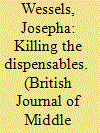

|
|
|
|
|
| Summary/Abstract |
In 2013, Aleppo province was engulfed in violence. The Syrian Arab Army (SAA) and affiliated Shi’a militias executed a campaign of massacres in the rural areas located on the eastern fringes of the province. The violence caused an exodus from this region, eventually dissipating local rural communities entirely. What can explain such extreme and brutal political violence perpetrated at a local level in the east Aleppo countryside throughout 2013? To find an answer, I analyse the personal accounts of those who witnessed the violence and YouTube videos. Taken together, these sources provide a visceral description of the massacres—in particular the summary executions in the village of Rasm al-Nafl, as a case study of extreme violence in one of the poorest rural areas of Syria. Problematizing mono-causal sectarian explanations, I argue that a deeper non-sectarian complex of rurality and a process of subaltern othering in combination with opportunism, governmental retribution, and strategic military concern for territorial control in order to secure alternative supply routes to Aleppo, ultimately led to the eradication of life and cultural genocide in these rural areas.
|
|
|
|
|
|
|
|
|
|
|
|
|
|
|
|
| 4 |
ID:
107542
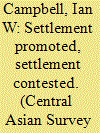

|
|
|
|
|
| Publication |
2011.
|
| Summary/Abstract |
The Shcherbina Expedition of 1896-1903 was the Russian Empire's most concerted effort to gather the data necessary to facilitate peasant settlers' migration to its largely nomadic steppe oblasts. Although this expedition was a massive exercise of imperial power privileging sedentary over mobile pastoralist lifeways, the oppositional views of its participants made matters more ambiguous. The civilizational hierarchies that emerged in its materials did not strictly privilege sedentary lifeways, and an effort was made to preserve mobile pastoralists' lifeways and economic wellbeing. The project of objectively correct colonization that the expedition embodied was initially embraced by all interested parties as a certain solution to the clash of lifeways brought about by peasant migration to the steppe. After its work was published, however, contested use of its statistical norms made it clear that the idea of 'correct colonization' could not prevent the serious conflicts engendered by settlement in the steppe.
|
|
|
|
|
|
|
|
|
|
|
|
|
|
|
|
| 5 |
ID:
122635
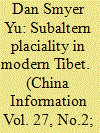

|
|
|
|
|
| Publication |
2013.
|
| Summary/Abstract |
I attempt to write this article as a pathology of modernity in connection with how place, memory, and subalternity are expressed by urban Tibetans in China. The literary works of Shogdong, a contemporary Tibetan writer and cultural critic, are the focus of my interpretation of the sociopolitical, religious, and psychological meanings of an anti-traditional discourse among urban Tibetans. My pathologizing this intra-Tibetan discourse is meant to discern how modern subjectivity or its mindscape in the case of urban Tibetans is inherently conditioned by place as both geographic landscape and locus of memory. I then argue that the negation of anti-traditional Tibetans of their native traditional cultural and religious values and practices is a remembering process which is inversed as a process of seemingly intentional subversion, rejection, and forgetting; and I further argue that the anti-traditionalist imagining of a modern Tibet, though it uses nomenclature identical to that of China's socialism, is not a replica of China's modernity, but an exercise of a power discourse in a subaltern sense.
|
|
|
|
|
|
|
|
|
|
|
|
|
|
|
|
| 6 |
ID:
054164
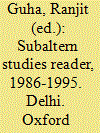

|
|
|
|
|
| Publication |
DelhI, Oxford University Press, 1998.
|
| Description |
xxii, 303p.Hbk
|
| Standard Number |
0195644352
|
|
|
|
|
|
|
|
|
|
|
|
Copies: C:1/I:0,R:0,Q:0
Circulation
| Accession# | Call# | Current Location | Status | Policy | Location |
| 040305 | 909/GUH 040305 | Main | On Shelf | General | |
|
|
|
|
| 7 |
ID:
191063
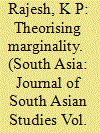

|
|
|
|
|
| Summary/Abstract |
Despite the accepted usage of ‘marginality’ as a subcategory of subalternity, seldom has the meaning of marginality as a concept been expounded. This paper sets out to address this lack by conceiving of ‘marginality’ as a condition, by focusing on the lived experiences of Adivasis in Kerala through the discourses constructed by a contemporary social movement, the Adivasi Gothra Maha Sabha (AGMS). Discourse analysis is the methodological frame that I have used in this paper to analyse the descriptions produced by the AGMS and the state of Kerala, and this is broadly situated within the post-colonial political-sociological approach. Premised on this, I argue that while marginality is an essential concept for looking at contemporary Adivasi movements in India, it is productive to interrogate and explore expanding the varied meanings attached to this concept.
|
|
|
|
|
|
|
|
|
|
|
|
|
|
|
|
|
|
|
|
|